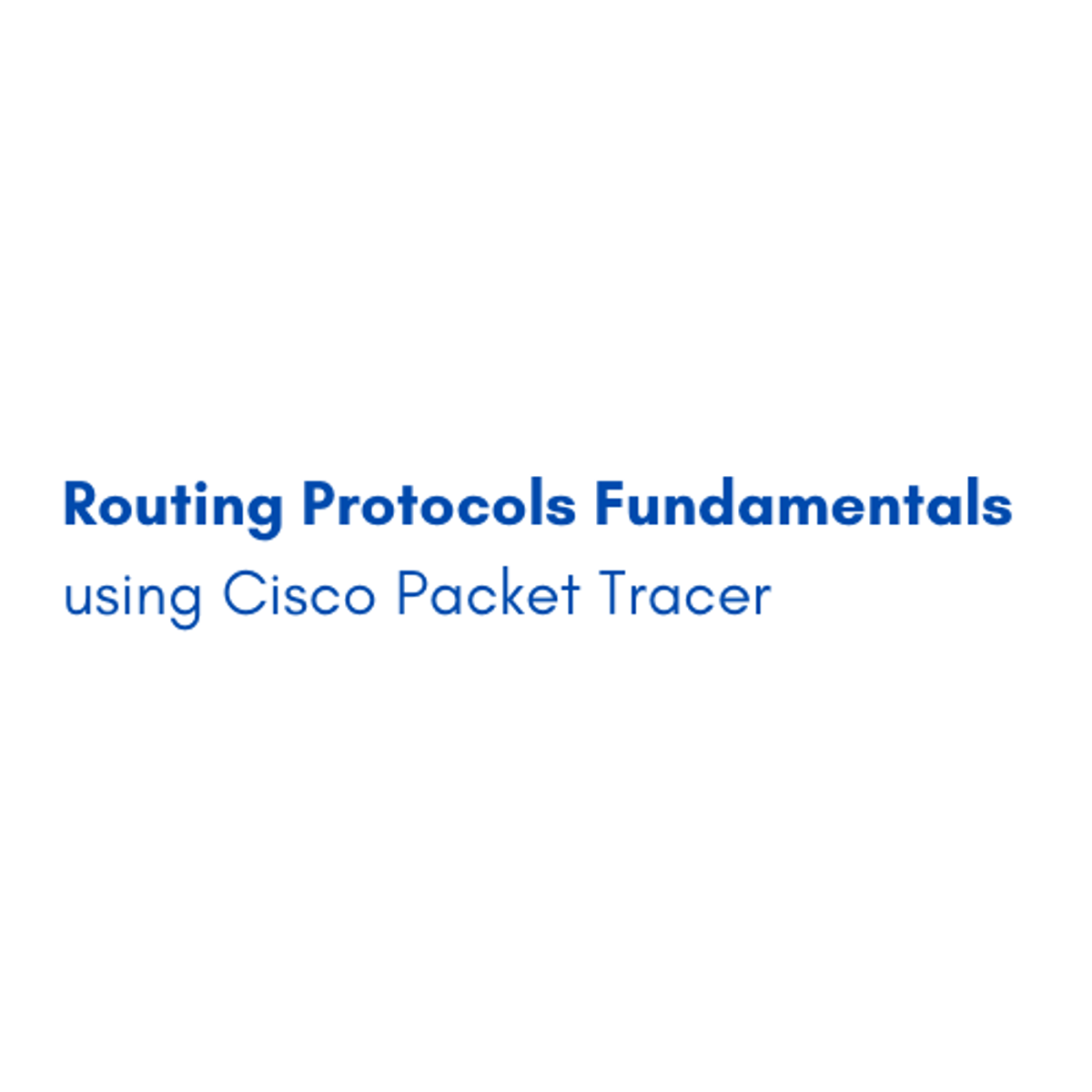Back to Courses









Information Technology Courses - Page 33
Showing results 321-330 of 1471

Publish your AppSheet App
This is a Google Cloud Self-Paced Lab. In this lab, you'll use AppSheet to publish your app.

Routing Protocols Fundamentals using Cisco Packet Tracer
In this 1-hour long project-based course, you will learn how to create a network topology using Cisco packet tracer. You will be able to apply basic configurations on network devices, identify the importance of routers in your network topology, and differentiate between the types of routing protocols, Moreover, you will be able to configure routing protocols as rip and EIGRP and OSPF on your router. Learning the routing protocols will provide you with the basics you need to begin working in the network engineering field. This guided project is for people who would like to enter the world of computer networking architecture and network administration. This project will enhance your skills in the networking field as learning routing protocols will benefit you much in your career as a network engineer.
Note: This course works best for learners who are based in the North America region. We’re currently working on providing the same experience in other regions.

Building Modern Python Applications on AWS
In modern cloud native application development, it’s oftentimes the goal to build out serverless architectures that are scalable, are highly available, and are fully managed. This means less operational overhead for you and your business, and more focusing on the applications and business specific projects that differentiate you in your marketplace. In this course, we will be covering how to build a modern, greenfield serverless backend on AWS.
Building brand new applications on AWS is a different task than lifting and shifting existing applications into AWS. When you have an existing application that you need to move to AWS, you might first look to using Amazon EC2 as your virtual machines, or maybe you might look into using docker containers and container hosting services like Amazon Elastic Container Service or Amazon Elastic Kubernetes Service. Those are all great application hosting options, but in most cases, they still require you to have some kind of pulse on the underlying infrastructure hosting your application. `
Building Modern Python Applications on AWS will explore how to build an API driven application using Amazon API Gateway for serverless API hosting, AWS Lambda for serverless computing, and Amazon Cognito for serverless authentication. We will follow an API driven development process and first mock up what the API will look like. We will cover all the ins and outs of the service Amazon API Gateway, and as you’ll learn- it does a lot more than just hosting an API.
Then we will add authentication to the API using Amazon Cognito. You’ll learn about how the authorization flow works with Cognito, and how to build it into your APIs. From there, we will add a Lambda backend that will be triggered by API Gateway. The lambda functions will be using the AWS SDKs to perform various data processing tasks. You’ll learn about the different configurations that exist for Lambda, and we will show you how to create and manage lambda functions. Some of the features of our API will require multiple lambda functions to execute in a specific order, like a workflow, and we will use AWS Step Functions to create a serverless workflow. Finally, we will talk about how to optimize your APIs at every layer using AWS features.
Note: There are four versions of this class, "Building Modern Node.js Applications on AWS" for Node.js developers, Building Modern Java Applications on AWS" for Java developers, "Building Modern .NET Applications on AWS" for .NET developers, and this course, "Building Modern Python Applications on AWS" for Python developers. The courses do for a large part, overlap and in general, we recommend that you take the course that focuses on the SDK you plan to use to develop your AWS Cloud based applications.
We expect that you have basic knowledge of AWS already. Some examples of concepts you should be familiar with are: you should know the basics of the AWS Global infrastructure, like what regions and availability zones are. You also should know the at a high-level AWS Identity and Access Management, or IAM, and how it is used to control access to AWS resources. You should also understand what an Amazon EC2 instance is, what Amazon S3 is, what a VPC is, as well as other basic AWS terminology.

Cisco: SD-WAN Cloud Hub with Google Cloud
This is a self-paced lab that takes place in the Google Cloud console. In this hands-on lab, you will learn how to leverage Google Service Directory and Cisco SD-WAN to optimize the performance of a video streaming application.

Linux: I/O Redirection for DevOps
In this 1-hour long project-based course on Linux i/o redirection for DevOps you will be working entirely on the command line and using powerful Linux commands and redirection operators to learn how input and output redirection works in Linux. You will get experience of taking control of what happens to the stdin and stdout of all your commands and no longer be confused about the details on how piping and redirection works in Linux.
This course is designed for any person working or who intends to work with Linux, from Linux system administrators to developers and DevOps practitioners. Or even if you are a student who is curious to get comfortable with Linux this course is for you also.
By the end of this course, you will have used all of the redirection operators to redirect data and you will be comfortable to do so with ease going forward. This will also allow you to possess one of the important foundations of Bash scripting.
This is an intermediate level course and is designed for an individual who has a beginner's knowledge of Linux command line and crud practices in computer science.
Note: This course works best for learners who are based in the North America region. We’re currently working on providing the same experience in other regions.

Connect and Configure Data for your AppSheet App
This is a Google Cloud Self-Paced Lab. In this lab, you'll use AppSheet to connect and configure data for your app.

Creating Derived Tables Using LookML
This is a Google Cloud Self-Paced Lab. In this lab, you create SQL derived and native derived tables in LookML to define new tables that do not already exist in the underlying database.

Juniper Cloud Concepts and Open Source Technologies
In this course, you will learn fundamental cloud computing concepts. This course covers key benefits of cloud computing, cloud service models such as SaaS and IaaS; public, private and hybrid cloud deployment models and open-source cloud technologies. You will learn about Linux virtualization techniques, QEMU-KVM, Libvirt and popular cloud instance initialization approach cloud-init. This course covers the concepts of namespaces and how to connect them through Linux bridges and OpenvSwitch. You will also learn about containerization through Docker, Dockerfile and Docker networking.

Predict Taxi Fare with a BigQuery ML Forecasting Model
This is a self-paced lab that takes place in the Google Cloud console. In this lab, you will explore millions of New York City yellow taxi cab trips available in a BigQuery Public Dataset, create an ML model inside of BigQuery to predict the fare, and evaluate the performance of your model to make predictions.

Check Point Jump Start - CloudGuard Workload Protection
The purpose of this program is to give you an insight into the security challenges involving workload protection and application security in the cloud, and Check Point’s solutions for those challenges. The program will also enable you to perform a basic deployment and configuration of the various solutions under the CloudGuard umbrella.
Chapter 1 - Program introduction
Chapter 2 – Introduction to Workload protection and application security
Lesson 1: Introduction to cybersecurity in the cloud
Lesson 2: Security challenges of cloud workloads
Lesson 3: CloudGuard Workload Protection
Chapter 3 - CloudGuard Workload Protection - Container Security
Lesson 1: Recap
Lesson 2: Runtime Protection
Lesson 3: Image Assurance
Lesson 4: Admission Control
Lesson 5: Threat Intelligence
Lesson 6: Posture Management
Lesson 7: Deployment
Lesson 8: Deployment troubleshooting
Chapter 4 - Shifting protection to the left with CloudGuard ShiftLeft
Lesson 1: Introduction to shifting security to the left
Lesson 2: Deployment
Chapter 5 – CloudGuard Workload protection - Serverless Security
Lesson 1: Serverless security
Lesson 2: CloudGuard Serverless Security for AWS Lambda
Lesson 3: Deployment
Chapter 6 – CloudGuard Application Security and API Protection
Lesson 1: Introduction to application security and API protection
Lesson 2: The CloudGuard AppSec solution
Lesson 3: Architecture and deployment considerations
Lesson 4: Deployment process
Lesson 5: Deployment
Lesson 6: Setting up API protection
Lesson 7: Data and customization of AppSec policy
Chapter 7 – Program summary
Check Point CloudGuard provides unified cloud-native security for all your assets and workloads, giving you the confidence to automate security, prevent threats, and manage posture – everywhere – across your multi-cloud environment.
Popular Internships and Jobs by Categories
Browse
© 2024 BoostGrad | All rights reserved


